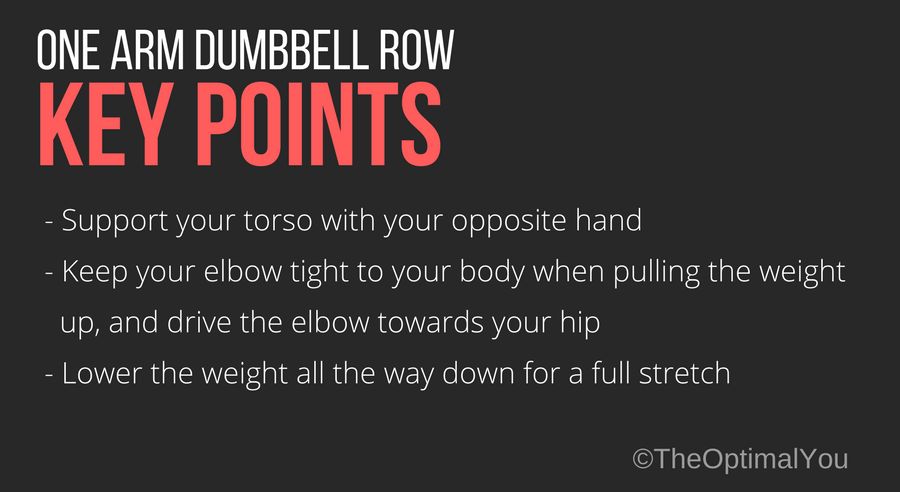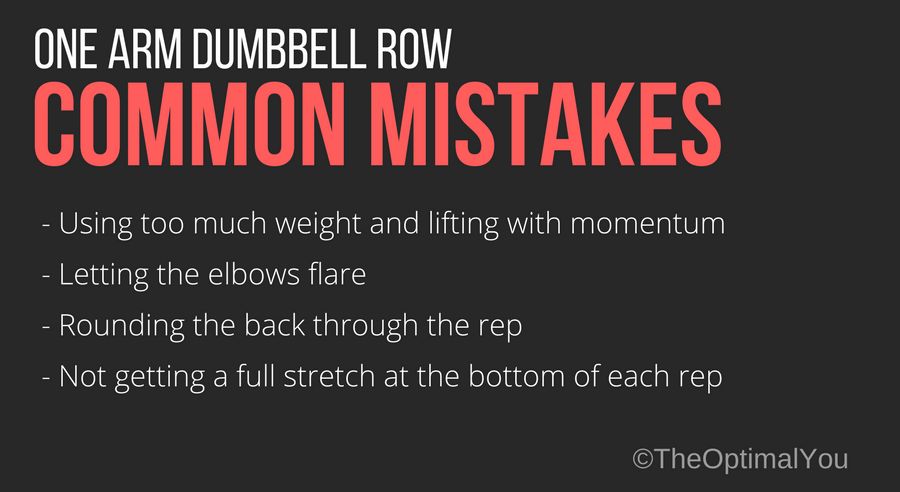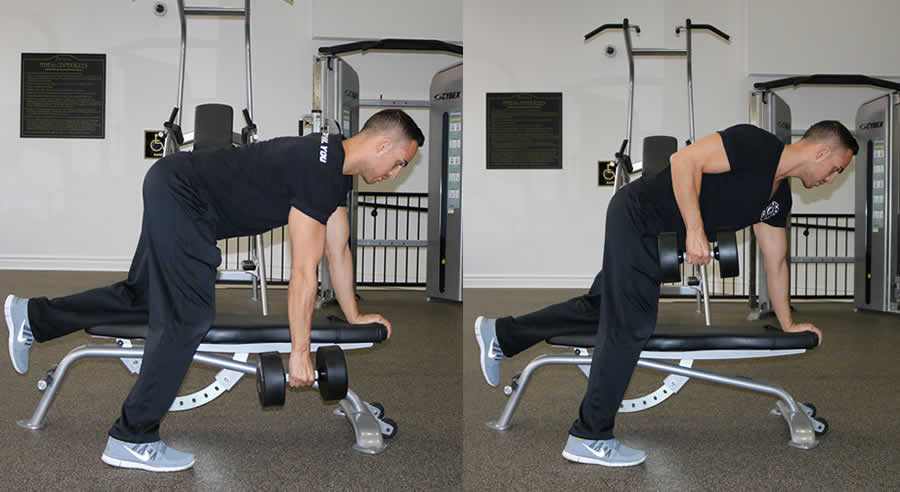Purpose or one-arm dumbbell rows
The one-arm dumbbell row is a versatile exercise designed to target muscles of the back, and based on how you do it will determine which muscles of the back take on the most amount of stress.
To cover all the ways to perform a dumbbell row to target various regions of the back would require several articles, so for simplicity, for the remainder of this article the one-arm row will be talked about for the purpose of targeting the lats.
Equipment needed for one-arm dumbbell rows
Not many exercises require less equipment than one-arm dumbbell rows, as all you really need is one single dumbbell – although a flat bench is often used to help stabilize the torso, it’s not required to do this exercise effectively.
Difficulty of one-arm dumbbell rows
On a scale of 1 to 5, one-arm dumbbell rows would rank around a 1, as they are extremely simple to do, however most people cannot actually feel the right muscles when doing this exercise.
So while it may be easy to perform, feeling it work is another story – in that case, it would rank around a 5, as the lats are very challenging for most people to engage on their own.
How to do one-arm dumbbell rows
To perform a one-arm dumbbell row, simply grab the dumbbell with one hand, and support your body with the other hand by either resting it on your knee, the dumbbell rack you got the dumbbell from, or on a flat bench.
Hips should be bent so the torso is parallel with the floor, arm hanging down towards the floor – this is the starting position. Initiate the pull by keeping your elbow as tight to your body as possible, driving the elbow back towards your hip – this is the plane of motion the lat is most responsible for when performing a row.
This is one of the few exercises where it is not recommended to pause at the top, as doing so generally will exhaust smaller muscles to a greater degree, like the forearms and biceps, which ultimately affects performance of the exercise.
Just focus on squeezing the lat, and then lowering the weight as controlled as possible down towards the ground – but don’t rest the weight on the floor.

Key points when doing the one-arm dumbbell row
- Support your torso with your opposite hand either on your knee, the dumbbell rack you got the dumbbell from, or a flat bench.
- Keep your elbow tight to your body when pulling the weight up, and drive the elbow towards your hip.
- Don’t worry about pausing at the top, just focus on squeezing the lat, and lower the weight towards the ground under control without actually resting the weight on the floor.
How many reps to perform when doing one-arm dumbbell rows
One-arm dumbbell rows lend themselves to the use of heavy weights better than most exercises. Also, because smaller, weaker muscles, like the forearms and biceps tend to fatigue quicker than the lats, lighter weights, and higher reps are not ideal.
The lats are a muscle group that needs to be forced to recruit, so heavier weights, and lower reps are ideal here.
This is not an excuse to use the heaviest weight you can, it just means to use heavier than you would for other exercise while being able to maintain proper form.
Common mistakes when doing one-arm dumbbell rows

Some of the more common mistakes when performing one-arm dumbbell rows are:
- Using too much weight – if the weight is too heavy, the movement becomes one in which momentum is generated to propel the weight up, which reduces muscle tension on the muscles you were trying to stimulate in the first place.
- Letting the elbow flare – the purpose of the one-arm dumbbell row (as it relates to the scope of this particular article) is to target the lat. The line of pull the lat is most responsible for is one in which the elbow remains close to the side of the body, driving it back towards the hip. If the elbow goes in any other direction the lat is no longer being targeted optimally – this is not bad if your goal is to target other areas of the back, but the purpose of this article is to shine light on how to do one-arm dumbbell rows to target the lat.
- Rounding forward through the back – often times what happens when people are focusing on the path of the elbow is they lost control of the rest of their body. This is common for exercises in which you have to keep your body rigid, and don’t have the luxury of lying on a bench where gravity would stabilize you on its own. In this case, don’t let your focus of one thing compromise your alignment.
- Not getting a full stretch at the bottom of each rep – to fully stimulate the lats you want to take them through their full range of motion so be sure to go all the way down.
Modifications to the one-arm dumbbell row
As stated, you can allow your elbow to flare when pulling to target different areas of the back.
By pulling out to your side, you more effectively direct stress onto the rhomboids, traps, and rear delts, so you must first determine where you want to target, and then perform the exercise in the way that best stimulates those regions.
When to do one-arm dumbbell rows
Because heavier weights are preferred, one-arm dumbbell rows are best to be done when you are fresh.
Typically at the end of a workout, other smaller muscles may be too fatigued, and thus negatively affect your ability to do one-arm dumbbell rows the way you need to, to get the most out of them.
Alternatives to one-arm dumbbell rows
There are many different row variations, but the primary alternative to a one-arm dumbbell row would be a one-arm machine row.
One-arm dumbbell rows vs. one-arm hammer strength rows
The primary benefit one-arm dumbbell rows has over nearly every other row variation has to do with its versatility, and practicality. You can modify it in a way that you can’t really replicate with a machine, and you can do them pretty much anywhere.
The benefit of one-arm hammer strength row is the resistance remains “on track,” so it’s easier to remain focused on alignment, since you can’t really change the trajectory of the resistance – it basically forces/teaches you to keep the elbow tight to the body.

